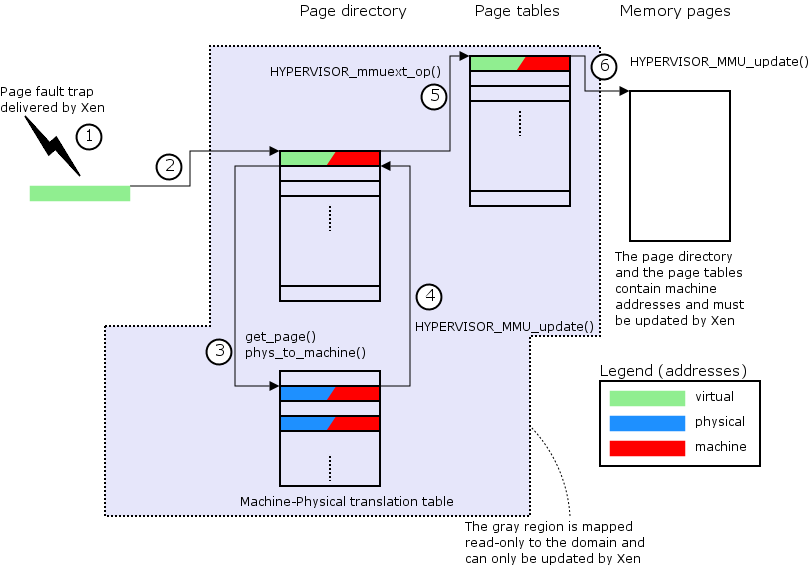| |
|
 |
|
 |
|
|
|
| |
|
|
xen-devel
[Xen-devel] Page fault handling for Xen guests
Hello!
I'm trying to understand how the Xen memory management works from a
guest OS perspective. I made a small figure to show how a page fault
is handled, and wanted to see if I've understood things
correctly. I'll add the description to the Wiki provided I didn't mix
things up. I've attached the figure in this mail.
We assume that an application causes a page fault on e.g., code in a
shared library, i.e. code that is in physical memory but not mapped to
the application. We'll assume that the page directory exists, but does
not have a page table or a page mapped for the faulting virtual
address. The following will then happen (steps are outlined in the
figure):
1. Xen receives the page fault and delivers it to the guest through
the trap table (installed by HYPERVISOR_set_trap_table()). The
guest will thereafter lookup a physical page to map into the
application.
page_fault_handler(virt_addr) {
...
pgdir_entry = virt_to_pgdir(virt_addr);
pgtab_entry = virt_to_pgtab(virt_addr);
phys_page = virt_to_phys(virt_addr);
...
2. The guest looks up the page directory and finds that there exists
no mapping (to a page table) for that address.
3. To get a new page table page, the guest will
* Get a new page (get_page()) for the page table
* Translate the pseudo-physical address of the page to a machine
address through the machine->physical translation table, e.g.,
pgtab = get_page();
pgtab_mach_addr = machine_to_physical(pgtab);
4. The guest inserts the machine address of the page table page into
the page directory through HYPERVISOR_MMU_update(), i.e., something
like (simplified syntax)
HYPERVISOR_mmu_update(pgdir_entry | MMU_NORMAL_PT_UPDATE, pgtab_mach_addr |
PGTAB_PROTECTION, ...);
(the page table page is now accessible)
5. The guest must then instruct Xen to pin this page as a page table
page (simplified syntax):
HYPERVISOR_mmuext_op(MMUEXT_PIN_L2_TABLE, pgtab_mach_addr, ...);
6. Finally the guest will map the physical page into the page table
phys_page_mach_addr = machine_to_physical(phys_page);
HYPERVISOR_mmuext_op(pgtab_entry | MMU_NORMAL_PT_UPDATE,
phys_page_mach_addr | PROTECTION, ...);
Have I understood this more or less correctly? If so, I'll add the
description and figure to the Wiki.
// Simon

_______________________________________________
Xen-devel mailing list
Xen-devel@xxxxxxxxxxxxxxxxxxx
http://lists.xensource.com/xen-devel
|
| <Prev in Thread] |
Current Thread |
[Next in Thread> |
- [Xen-devel] Page fault handling for Xen guests,
Simon Kagstrom <=
|
|
|
| |
|

